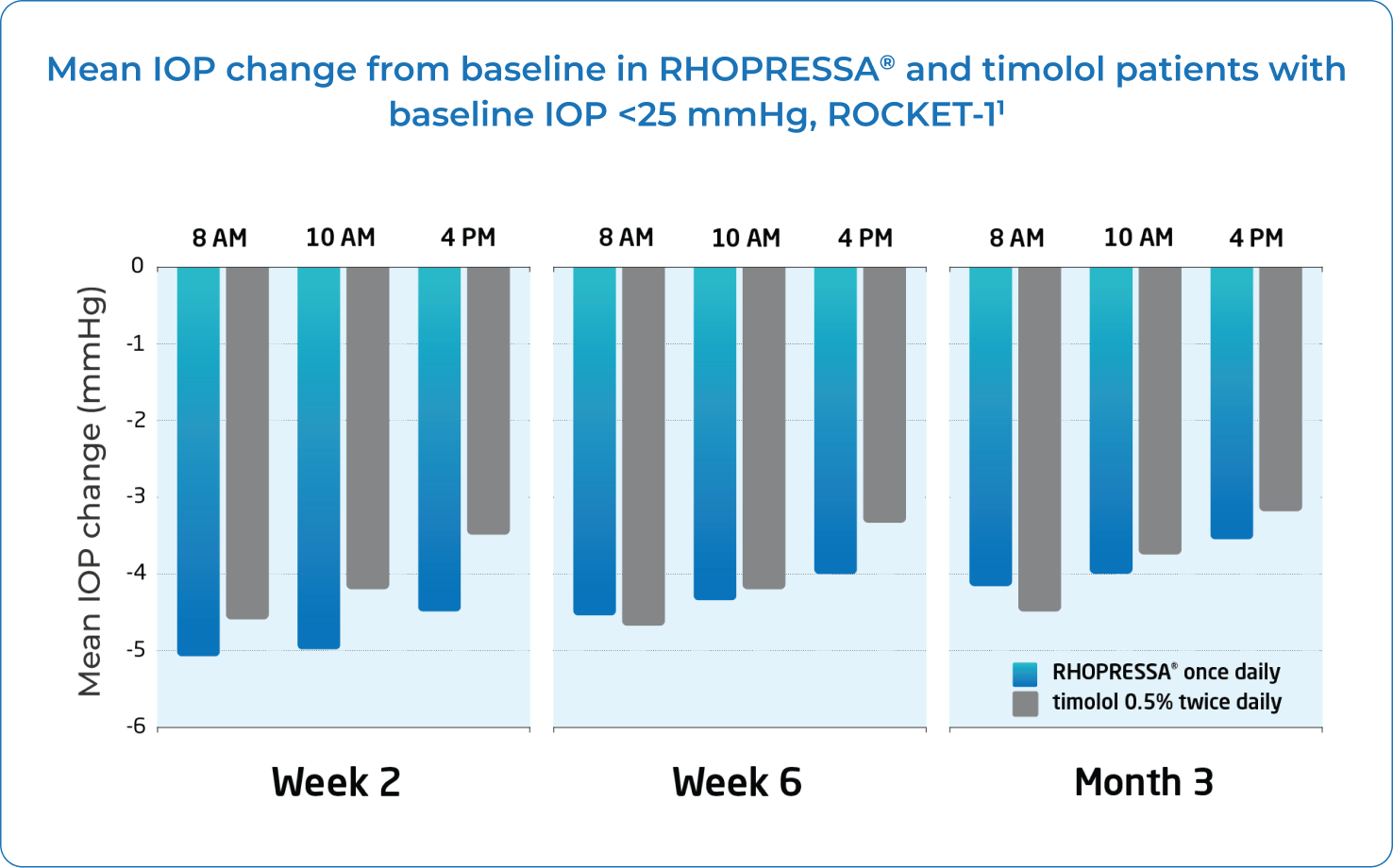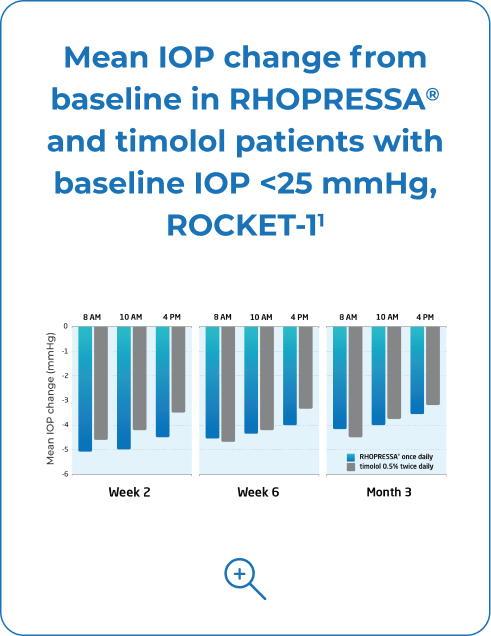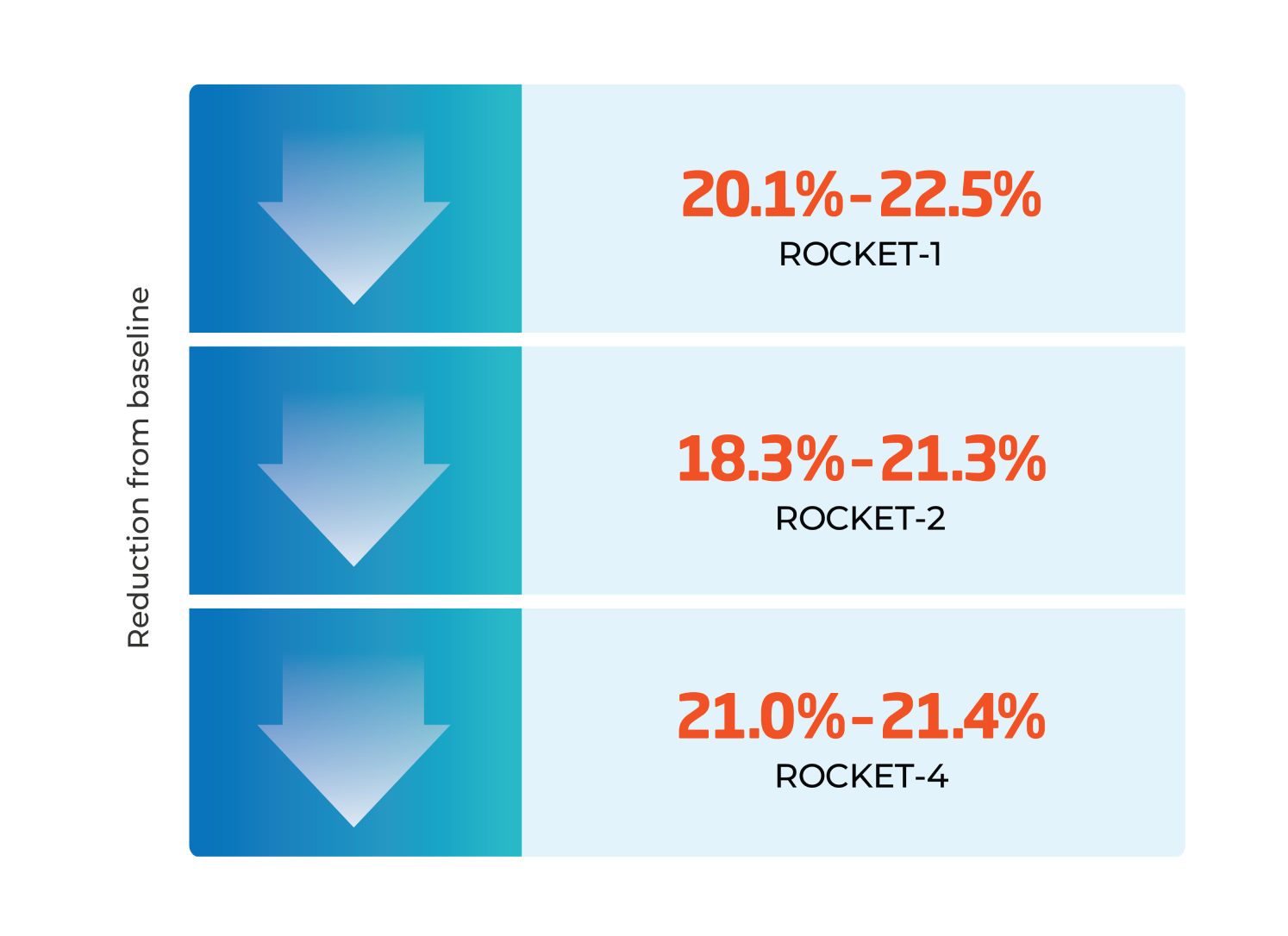Take control with RHOPRESSA®
(netarsudil ophthalmic solution) 0.02%
RHOPRESSA® provided IOP reduction up to
5 mmHg in patients with baselines <25 mmHg1


Study Design
RHOPRESSA® was evaluated in 3 randomized, controlled clinical trials in patients with open-angle glaucoma or ocular hypertension, and baseline IOP lower than 27 mmHg (in 3- and 12-month studies) or lower than 30 mmHg (in a 6-month study). For patients with baseline IOP <25 mmHg, the IOP reductions with RHOPRESSA® dosed once daily were similar to those with timolol 0.5% dosed twice daily. For patients with baseline IOP ≥25 mmHg, RHOPRESSA® resulted in smaller mean IOP reductions at the morning time points on Days 43 and 90; the difference in mean IOP reduction between the 2 treatment groups was as high as 3 mmHg, favoring timolol.1
Up to 21% reduction in IOP on Day 152*


*Measured at 8:00 AM, 10:00 AM, and 4:00 PM.2
Approximately half of subjects achieved mean diurnal IOP <17 mmHg across all visits over 3 months from an average baseline IOP of 22.5 mmHg2
For patients like Mary, add RHOPRESSA® for additional IOP control
For patients like Mary, add RHOPRESSA® for additional IOP control
PATIENT DETAILS†
- 73 years old
- Open-angle glaucoma
- Currently taking latanoprost and had a 3-month supply at home
- ROCKLATAN® coverage denied
- Has asthma and a history of pulmonary hypertension
PATIENT STATUS
- Current treatment regimen has reduced her IOP from 24 mmHg to 18 mmHg
- Mary’s ECP would like to get her down to a target IOP of 14 mmHg
TREATMENT PLAN
RHOPRESSA® has been shown to reduce IOP through a different MOA and has no contraindications1,3
†Hypothetical patient.
ECP=Eye care professional;
IOP=Intraocular pressure;
mmHg=Millimeters of mercury;
MOA=Mechanism of action.
REFERENCES
1. Rhopressa® (netarsudil ophthalmic solution) 0.02% Prescribing Information, AeriePharmaceuticals, Inc., Irvine, CA. 2019.
2. Alcon data on file, 2022.
3. Xalatan (latanoprost ophthalmic solution) 0.005% Prescribing Information, Pfizer Laboratories, New York, NY. 2020.
IMPORTANT SAFETY INFORMATION
Warnings and Precautions
Epithelial Corneal Edema: Epithelial Corneal Edema, described as honeycomb or bollous, has been reported in some patients with pre-existing corneal stromal edema or following ocular procedures that could affect corneal endothelial function. Epithelial corneal edema typically resolves upon discontinuation of RHOPRESSA. Advise patients to notify their physician if they experience eye pain or decreased vision while using RHOPRESSA.
Bacterial Keratitis: There have been reports of bacterial keratitis associated with the use of multiple-dose containers of topical ophthalmic products. These containers had been inadvertently contaminated by patients who, in most cases, had a concurrent corneal disease or a disruption of the ocular epithelial surface.
INDICATIONS AND USAGE
Rhopressa® (netarsudil ophthalmic solution) 0.02% is indicated for the reduction of elevated intraocular pressure in patients with open-angle glaucoma or ocular hypertension.
Contact Lenses: Contact lenses should be removed prior to instillation of Rhopressa® and may be inserted 15 minutes following its administration.
Adverse Reactions
The most common ocular adverse reaction observed in controlled clinical studies with Rhopressa® dosed once daily was conjunctival hyperemia, reported in 53% of patients. Six percent of patients discontinued therapy due to conjunctival hyperemia. Other common (approximately 20%) adverse reactions were: corneal verticillata, instillation site pain, and conjunctival hemorrhage. Instillation site erythema, corneal staining, blurred vision, increased lacrimation, erythema of eyelid, and reduced visual acuity were reported in 5-10% of patients.
The corneal verticillata seen in Rhopressa®- treated patients were first noted at 4 weeks of daily dosing. This reaction did not result in any apparent visual functional changes. Most corneal verticillata resolved upon discontinuation of treatment.
Please click here for full prescribing information for Rhopressa®.
You are encouraged to report negative side effects of prescription drugs to the FDA. Visit www.fda.gov/medwatch or call 1-800-FDA-1088.
DOSAGE AND ADMINISTRATION
The recommended dosage is one drop in the affected eye(s) once daily in the evening.
